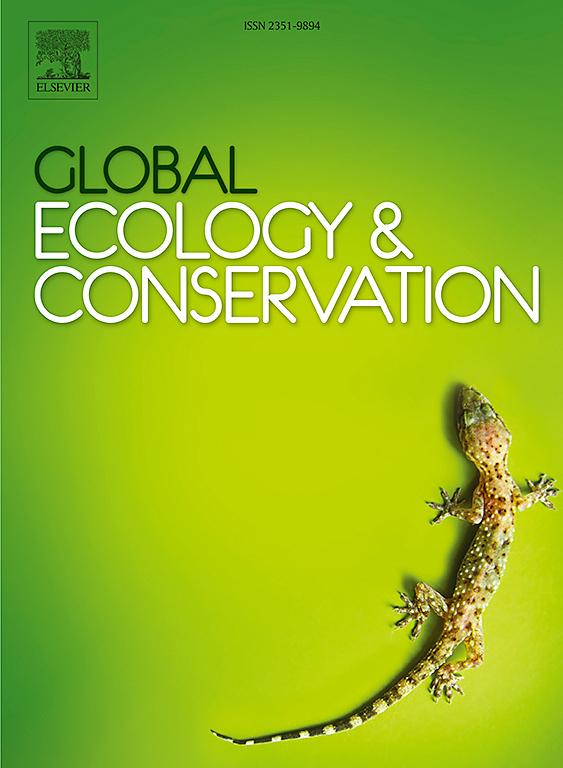Effects of regional species pool, climate and forest structure on tree layer species richness in natural evergreen broad-leaved forests: A regional-scale analysis from Jiangxi, China
IF 3.4
2区 环境科学与生态学
Q1 BIODIVERSITY CONSERVATION
引用次数: 0
Abstract
The ongoing loss of species diversity highlights necessitates elucidating the drivers of species richness to inform biodiversity conservation and sustainable forest management strategies. This study leveraged data from 1739 vegetation plots from natural evergreen broad-leaved forests from the 2019 forest management inventory in Jiangxi Province, China. A boosted regression trees model was employed to assess regional effects on species richness, followed by the construction of a structural equation model (SEM) to elucidate the direct and indirect pathways of key drivers on tree layer species richness. The results revealed a tree layer species richness range of 3–17, with higher richness values predominantly in the northern, western, and southern regions. Species richness declined significantly with increasing latitude (P < 0.05). About 40 % of the variation in tree layer species richness can be accounted for by the regional species pool (SP) and the selected regional environmental factors. The SEM revealed that SP, stand basal area per unit area (BA) and precipitation seasonality (PS) directly and positively affected tree layer species richness, while precipitation of driest quarter (PDQ) negatively affected richness directly. Tree layer species richness was affected indirectly by the anomaly in annual mean temperature from the Last Glacial Maximum to the present (AnomalyRAMT) and regional annual mean temperature (RAMT) through SP, and by PDQ and precipitation of warmest quarter (PWAQ) through BA. Hence, conserving high-richness areas can help maintain elevated levels of biodiversity. Incorporating regional and local environmental factors, along with the regional species pool, significantly improves the comprehension of the mechanisms that affect species richness.
区域物种库、气候和森林结构对天然常绿阔叶林乔木层物种丰富度的影响——以江西为例
物种多样性的持续丧失突出表明,有必要阐明物种丰富度的驱动因素,为生物多样性保护和可持续森林管理战略提供信息。本研究利用了来自中国江西省2019年森林经营清查中的1739个天然常绿阔叶林植被样地的数据。采用增强回归树模型评估物种丰富度的区域效应,并构建结构方程模型(SEM)来阐明影响树层物种丰富度的主要驱动因素的直接和间接途径。结果表明:乔木层物种丰富度在3 ~ 17之间,丰富度较高的地区主要分布在北部、西部和南部。物种丰富度随纬度的增加而显著下降(P <; 0.05)。约40 %的乔木层物种丰富度变化可由区域物种库(SP)和选定的区域环境因子来解释。SEM结果表明,SP、林分单位面积基础面积(BA)和降水季节性(PS)对乔木层物种丰富度有直接的正向影响,而最干燥季降水量(PDQ)对乔木层物种丰富度有直接的负向影响。末次盛冰期至今年平均温度异常(AnomalyRAMT)和区域年平均温度异常(RAMT)通过SP间接影响乔木层物种丰富度,PDQ和最暖季降水(PWAQ)通过BA间接影响乔木层物种丰富度。因此,保护高丰富度地区有助于维持较高的生物多样性水平。结合区域和局部环境因素,以及区域物种库,可以显著提高对物种丰富度影响机制的理解。
本文章由计算机程序翻译,如有差异,请以英文原文为准。
求助全文
约1分钟内获得全文
求助全文
来源期刊

Global Ecology and Conservation
Agricultural and Biological Sciences-Ecology, Evolution, Behavior and Systematics
CiteScore
8.10
自引率
5.00%
发文量
346
审稿时长
83 days
期刊介绍:
Global Ecology and Conservation is a peer-reviewed, open-access journal covering all sub-disciplines of ecological and conservation science: from theory to practice, from molecules to ecosystems, from regional to global. The fields covered include: organismal, population, community, and ecosystem ecology; physiological, evolutionary, and behavioral ecology; and conservation science.
 求助内容:
求助内容: 应助结果提醒方式:
应助结果提醒方式:


